More Bugs!

The heyday of the semiautomatic key or bug was probably between 1920 and
1950. Between 1904 and 1920, spark limited the usefulness of the bug, though bugs were
still used on many landline circuits. After the advent of continuous wave transmitters
which allowed the use of bugs on wireless circuits, the bug took off in popularity and
many new manufacturers sprang up. Check out the 'Virtual Bug' by AE4RV.
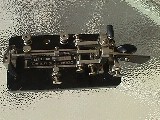
Leach Relay Co.
Leach Relay Co. apparently made two models, which they called "The Speedoplex". The No.1 must be quite rare, as
I have never seen one! The No.2 is pictured here. This bug is a copy of the
Vibroplex original style of key. It was made in San Francisco, CA circa 1930
and must have been contemporary with Logan's Speed-X.
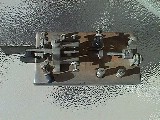
Standard Radio Co.
The Standard Radio Co. of New York City made a very heavy, solid bug which also was
basically a copy of the Vibroplex original. These bugs were made with and without labels,
but can be easily identified by the very heavy U-shaped damper, and the slotted contact
posts which are mounted on thin, round bases. This bug is nickel-plated, but there were
other finishes available.
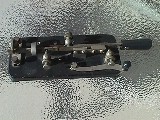
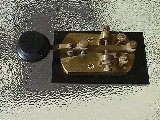
Signal Electric Co. of Menominee, MI
The Sematic was made by the Signal Electric Co., the same company that made the
very familiar brass straight keys with the mica insulation on the bottom. The Sematic
was a light weight bug which was intended, like the early Go-Devil, to be used either
as a bug or as a sideswiper with symmetrical contacts (partially missing on this
example) and a locking damper.
Computer languages have come a long way in the past couple of decades. There are
two broad classifications of computer languages: low level and high level. Low level
languages communicate with a computer rather directly in a way that most people would not recognize--
binary or base 16 numbers. This type of thing is called "machine language". When machine
language is made simpler by adding letter abbreviations for each instruction, it is called
"assembly language". High-level languages are oriented toward the user and appear more
familiar with recognizable words and phrases. The Beginner's All-Purpose Symbolic Instruction
Code (BASIC) was developed at Dartmouth College as a High Level programming language and was
widely used in the 1980's. JAVA is a much more modern and powerful language and is widely used for
interactivity on the internet. To see the JAVA program which displays the picture above,
click the applet. Adapted from the ARRL Handbook, 1987.
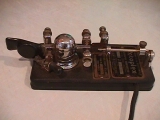
Martin's Rotoplex by James Clark Jr. Electric Co.
The Rotoplex is a bug with a large central bearing for the lever arm. Horace G. Martin designed this bug after leaving
The Vibroplex Company. The manufacture year is 1943, and it was made for the Signal Corps. In spite of that, there is no
designation on the label that this was received as a J-36. It appears that Martin subcontracted the manufacture of the
Rotoplex to James Clark Jr. Electric Co. of Louisville, Kentucky. The bottom of this bug is flat rubber to adhere to the
operating surface instead of rubber feet. Another departure from the usual Martin bugs is an integral cord and wedge
assembly. Gone are the binding posts to attach the cord.
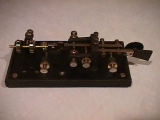
Kenco
The Kenmore Company of Boston Mass. made the "Kenco" bug from about 1934-1941. The parts are mounted on
bakelite, which is in turn mounted on a cast iron base. I have been told that this bug was marketed at one time through
at least one Radio Shack franchise in Boston.
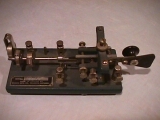
Wilson Mfg. Co.
The Wilson Mfg. Co. of Toronto Canada made this Model SA100. The curved wings were made like a McElroy T-bar bug,
but are somewhat more stylish. Apparently, the rubber feet could be removed from the bottom and screwed into position
instead of the placeholder screws on top, making the bug a lefthander!
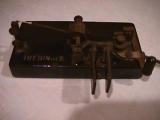
D & K Mfg.
The D & K Mfg. Co. of Cleveland, Ohio manufactured the Dinger bug and the Wizard add-on type straight key about 1909. The company was owned by and named after Paul Dinger and August Krastin.
The Dinger operated on the Bellows tension-release type mechanism rather than the Vibroplex principle. The design of the
Dinger was a departure from the usual. Many of the parts are underneath the base.
Signal Strength
Unfortunately, the system we use to measure signal strength is not very intuitive.
Use the applet below to see what happens to dB gain and signal strength of a station as you change the output power of a station. The power on the left is the final power output, the power on the right is the initial power output. Initially, the "S unit" scale was completely arbitrary. Eventually an attempt was made to standardize the scale, so S-9 was given a definite value and 6 dB was decided upon as the difference between S units.
A "dB" or decibel is the smallest increment of sound that is detectable by the human ear. It was named after Alexander Graham Bell of telephone fame. As a rule of thumb, if you multiply power by a factor of 10, you add 10 dB strength. The relationship is not linear however but a logarithmic comparison of the two signal strengths, so doubling the power adds about 3 dB. Six dB approximates one "S unit" on a signal strength meter and requires approximately 4 times the signal strength.

 Back to the Index
Back to the Index











 Back to the Index
Back to the Index